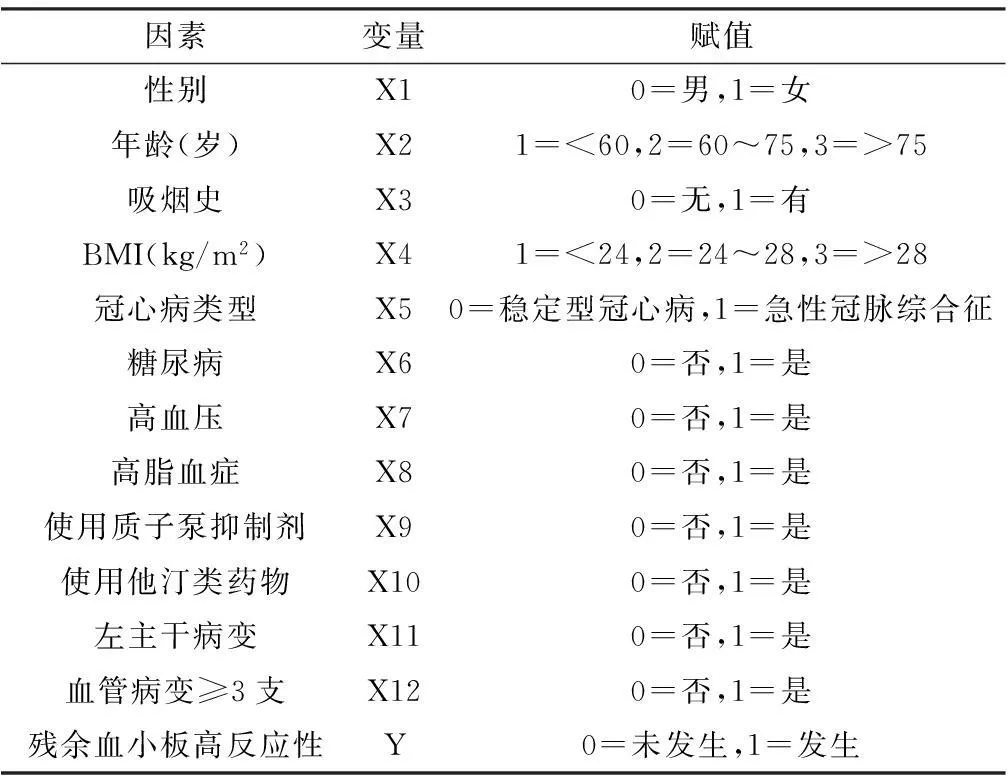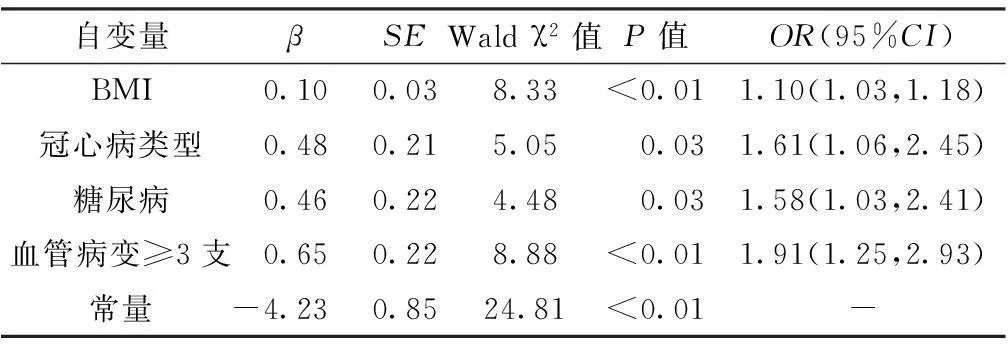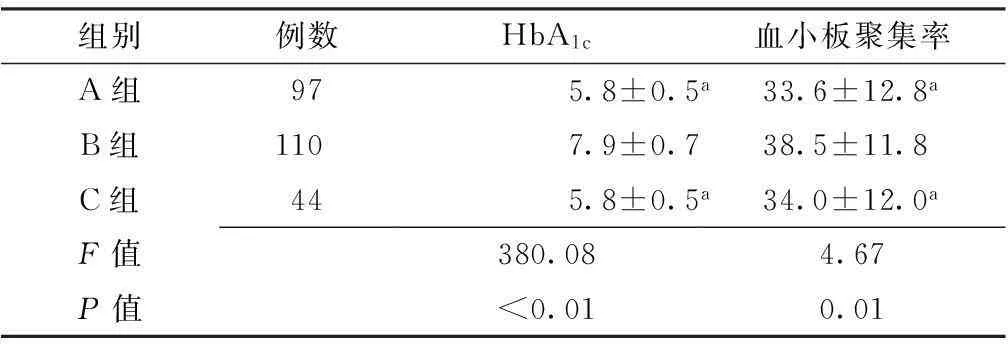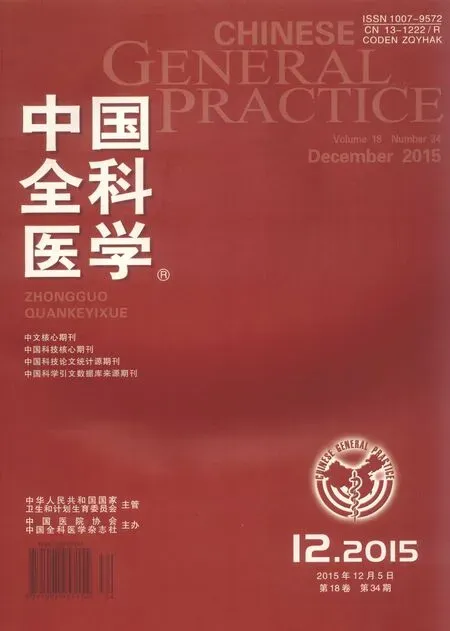冠心病患者氯吡格雷治疗后残余血小板高反应性的影响因素研究
·论著·
冠心病患者氯吡格雷治疗后残余血小板高反应性的影响因素研究
吴建萍,徐丹苹,吴焕林
作者单位:510405 广东省广州市,广州中医药大学第二临床医学院(吴建萍);广东省中医院心脏中心(徐丹苹,吴焕林)
通信作者:徐丹苹,510120 广东省广州市,广东省中医院心脏中心;E-mail:xudanping@hotmail.com;
吴焕林,510120 广东省广州市,广东省中医院心脏中心;E-mail:doctorwuhl@sina.com
【摘要】目的 探讨冠心病患者发生氯吡格雷治疗后残余血小板高反应性(残余血小板高反应性)的影响因素。方法 选取2014年1—12月到广东省中医院住院治疗的冠心病患者513例。根据是否发生残余血小板高反应性,将患者分为高反应性组(n=125)和非高反应性组(n=388)。采用查询病历法,收集患者的一般资料,包括住院号、姓名、性别、年龄、吸烟史、BMI、冠心病类型、合并症、用药情况、左主干病变情况、病变血管数量、血小板聚集率及糖化血红蛋白(HbA1c)水平等。结果 单因素分析显示,不同BMI、冠心病类型、糖尿病合并情况、血管病变≥3支患者的残余血小板高反应性发生率比较,差异有统计学意义(P<0.05);不同性别、年龄、吸烟史、高血压合并情况、高脂血症合并情况、质子泵抑制剂使用情况、他汀类药物使用情况、左主干病变情况患者的残余血小板高反应性发生率比较,差异无统计学意义(P>0.05)。多因素非条件Logistic回归分析显示,BMI、冠心病类型、糖尿病合并情况、血管病变≥3支对冠心病患者发生残余血小板高反应性的影响有统计学意义(P<0.05)。Pearson相关分析显示,HbA1c和血小板聚集率呈正相关关系(r=0.59,P<0.05)。结论 BMI、冠心病类型、糖尿病合并情况、血管病变≥3支是冠心病患者发生残余血小板高反应性的影响因素,且HbA1c越高,血小板聚集率越高,残余血小板高反应性越强。
【关键词】冠心病;残余血小板高反应性;影响因素分析
基金项目:国家自然科学基金资助项目(81403341)——基于血小板膜P2Y12受体介导的信号通路探讨参术冠心方抗栓作用机制;广东省中医院(广东省中医药科学院)中医临床评价研究专项(YN2014PJ08)——参术冠心方治疗择期PCI术后患者氯吡格雷抵抗的临床研究
【中图分类号】R 541.4
收稿日期:(2015-08-03;修回日期:2015-10-30)
吴建萍,徐丹苹,吴焕林.冠心病患者氯吡格雷治疗后残余血小板高反应性的影响因素研究[J].中国全科医学,2015,18(34):4192-4195.[www.chinagp.net]
Wu JP,Xu DP,Wu HL.Influencing factors for high residual platelet reactivity in patients with coronary heart disease after clopidogrel treatment[J].Chinese General Practice,2015,18(34):4192-4195.
Influencing Factors for High Residual Platelet Reactivity in Patients With Coronary Heart Disease After Clopidogrel TreatmentWUJian-ping,XUDan-ping,WUHuan-lin.TheSecondClinicalMedicalCollege,GuangzhouUniversityofChineseMedicine,Guangzhou510405,China
Abstract【】ObjectiveTo explore the influencing factors for high residual platelet reactivity in patients with coronary heart disease after clopidogrel treatment.MethodsWe enrolled 513 patients with coronary heart disease who were admitted into Guangdong Province Hospital of Traditional Chinese Medicine from January to December in 2014.According to whether high residual platelet reactivity occurred,the patients were divided into two groups:reactivity group(n=125) and non-reactivity group(n=338).Medical record query method was employed,general data were collected,including admission number,name,gender,age,smoking history,BMI,type of coronary heart disease,complications,situation of medication,situation of left main coronary artery lesion,the number of diseased coronary arteries,HbA1c,etc.ResultsUnivariate analysis showed that patients with different situations of BMI,type of coronary heart disease,complication with diabetes and the number of diseased coronary arteries≥3 were significantly different in the incidence of high residual platelet reactivity(P<0.05);patients with different gender,age,smoking history and different situations of complications with hypertension,complication with hyperlipidaemia,usage of proton pump inhibitor,usage of statins and left main coronary artery lesion were not significantly different in the incidence of high residual platelet reactivity(P>0.05).Multivariate non-conditional logistic regression analysis showed that BMI,kind of coronary disease,complication with diabetes,number of diseased coronary arteries≥3 had significant influence on the incidence of high residual platelet reactivity(P<0.05).Pearson correlation analysis showed that HbA1cwas positively correlated with platelet aggregation rate(r=0.59,P<0.05).ConclusionBMI,type of coronary heart disease,complication with diabetes and triple vessel disease are the risk factors for high residual platelet reactivity in patients with coronary heart disease,higher HbA1cis associated with higher platelet aggregation rate and higher residual platelet reactivity.
【Key words】Coronary disease;High residual platelet reactivity;Root cause analysis
部分冠心病患者规范采用氯吡格雷进行抗血小板治疗后,血小板仍呈高反应性,称为氯吡格雷治疗后残余血小板高反应性(残余血小板高反应性)。其既可以通过各种炎性病变途径加速冠状动脉粥样硬化进程[1],也可以推动冠心病血栓事件等并发症的发生[2]。基因变异(如CYP2C19基因突变)是残余血小板高反应性的原因之一,但并不是唯一因素,机体的临床状况也同样是不可忽略的重要部分。本研究回顾性分析了513例冠心病患者的临床资料,旨在探讨冠心病患者残余血小板高反应性的影响因素。
1对象与方法
1.1研究对象选取2014年1—12月到广东省中医院住院治疗的冠心病患者513例。纳入标准:(1)服用有专利的硫酸氢氯吡格雷片75 mg/d,≥7 d;(2)住院期间进行了二磷酸腺苷(ADP)诱导的血小板聚集率检测。排除标准:(1)存在氯吡格雷敏感性;(2)曾采用替罗非班进行治疗;(3)伴严重造血系统疾病;(4)既往有凝血系统疾病、血小板减少症及贫血史;(5)伴感染、肿瘤及免疫系统疾病。该研究通过了本院伦理委员会的批准,纳入患者均知情同意。
1.2诊断标准冠心病的诊断标准参照《缺血性心脏病的命名及诊断标准》[3]。残余血小板高反应性的诊断标准:服用有专利的硫酸氢氯吡格雷片,75 mg/d,≥7 d;采用光学比浊法,以5 μmol/L的ADP诱导,血小板最大聚集率>46.0%[4]。
1.3研究方法根据是否发生残余血小板高反应性,将患者分为高反应性组(n=125)和非高反应性组(n=388)。采用查询病历法,收集患者的一般资料,包括住院号、姓名、性别、年龄、吸烟史(吸烟>1年)、BMI、冠心病类型、合并症(糖尿病、高血压、高脂血症)、用药情况(质子泵抑制剂、他汀类药物)、左主干病变情况、病变血管数量、血小板聚集率及糖化血红蛋白(HbA1c)水平等。

2结果
2.1冠心病患者发生残余血小板高反应性影响因素的单因素分析513例患者中,共有125例患者发生残余血小板高反应性,残余血小板高反应性的发生率为24.4%。以是否发生残余血小板高反应性为因变量,以患者一般情况为自变量(各因素赋值情况见表1),进行单因素分析。结果显示,不同BMI、冠心病类型、糖尿病合并情况、血管病变≥3支患者的残余血小板高反应性发生率比较,差异有统计学意义(P<0.05);不同性别、年龄、吸烟史、高血压合并情况、高脂血症合并情况、质子泵抑制剂使用情况、他汀类药物使用情况、左主干病变情况患者的残余血小板高反应性发生率比较,差异无统计学意义(P>0.05,见表2)。
2.2冠心病患者发生残余血小板高反应性影响因素的多因素分析以是否发生残余血小板高反应性为因变量,以性别、吸烟史、高脂血症合并情况及单因素分析中差异有统计学意义的因素为自变量,进行多因素非条件Logistic回归分析。结果显示,BMI、冠心病类型、糖尿病合并情况、血管病变≥3支对冠心病患者发生残余血小板高反应性的影响有统计学意义(P<0.05,见表3)。

表1 各因素赋值情况
注:残余血小板高反应性=氯吡格雷治疗后残余血小板高反应性
表2冠心病患者残余血小板高反应性影响因素的单因素分析〔n(%)〕
Table 2Univariate analysis of influencing factors for high residual platelet reactivity in patients with coronary heart disease

自变量例数残余血小板高反应性χ2值P值性别0.720.40 男31673(23.1) 女19752(26.4)年龄(岁)1.640.44 <6011223(20.5) 60~7521452(24.3) >7518750(26.7)吸烟史0.070.79 无27265(23.9) 有24160(24.9)BMI(kg/m2)71.69<0.01 <2427850(18.0) 24~2819467(34.5) >28418(19.5)冠心病类型4.440.04 稳定型冠心病29662(20.9) 急性冠脉综合征21763(29.0)糖尿病7.180.01 否28757(19.9) 是22668(30.1)高血压0.190.66 否13932(23.0) 是37493(24.9)高脂血症0.430.51 否29268(23.3) 是22157(25.8)使用质子泵抑制剂3.090.08 否12022(18.3) 是393103(26.2)使用他汀类药物2.010.16 否131(7.7) 是500124(24.8)左主干病变0.010.90 否453110(24.3) 是6015(25.0)血管病变≥3支12.31<0.01 否27149(18.1) 是24276(31.4)
2.3血小板聚集率与HbA1c的关系513例患者中,共有251例进行了HbA1c检测,其中无糖尿病患者97例(A组),糖尿病患者154例。154例糖尿病患者中,HbA1c≥6.5% 110例(B组),HbA1c<6.5% 44例(C组)。3组HbA1c水平和血小板聚集率比较,差异有统计学意义(P<0.05);且B组与A组、B组与C组的HbA1c和血小板聚集率比较,差异均有统计学意义(P<0.05,见表4)。Pearson相关分析显示,HbA1c和血小板聚集率呈正相关关系(r=0.59,P<0.05)。
表3冠心病患者发生残余血小板高反应性影响因素的多因素非条件Logistic回归分析
Table 3Multivariate logistic regression analysis of influencing factors for high residual platelet reactivity in patients with coronary heart disease

自变量βSEWaldχ2值P值OR(95%CI)BMI0.100.038.33<0.011.10(1.03,1.18)冠心病类型0.480.215.050.031.61(1.06,2.45)糖尿病0.460.224.480.031.58(1.03,2.41)血管病变≥3支0.650.228.88<0.011.91(1.25,2.93)常量-4.230.8524.81<0.01-
注:-表示无该数据

Table 4Comparison of glycosylated hemoglobin and platelet aggregation rate between the three groups

组别例数HbA1c血小板聚集率A组975.8±0.5a33.6±12.8aB组1107.9±0.738.5±11.8C组445.8±0.5a34.0±12.0aF值380.084.67P值 <0.010.01
注:HbA1c=糖化血红蛋白;与B组比较,aP<0.05
3讨论
世界心脏病联盟发表专家共识指出,新型抗血小板药物临床试验纳入的东亚人群较少,鉴于东亚人群与白种人群的出血和凝血情况不同,故将其推广至东亚患者缺乏循证医学证据[5]。因此,未来很长一段时间内,氯吡格雷仍为我国血小板疾病治疗的重要一线药物。但氯吡格雷进行抗血小板治疗存在反应多样性,高活化率可以加速动脉粥样硬化进程,并参与后期血栓事件等并发症的发生,故其残余血小板高反应性仍为临床关注焦点。
光学比浊法是测量血小板功能的金标准[6],由于其价格低廉、易于普及、与缺血事件的相关性较好,故为我国临床较为常用的检测方法。目前,临床研究多采用血小板聚集率绝对值和治疗前后差值这两种指标进行评价。抗血小板治疗后与治疗前的差值,更适用于评价药物对特定靶点的作用;而不适用于评价机体血小板活化情况及其对预后的影响,如检查示无反应性(<10.0%)可能会高估血小板活化基线水平低患者的缺血风险,而反应良好(>30.0%)可能会过低估计血小板活化基线水平高患者的缺血风险[7-8]。因此,对于缺血风险的预测,抗血小板治疗后的血小板聚集率绝对值是更为恰当的指标[9]。患病时,表现型(如血小板聚集率)是个体血小板活化程度的最终体现,较基因型更能预测不良临床事件、指导抗血小板治疗[10];基因型突变为残余血小板高反应性的原因之一[11],但并非所有基因突变者都存在血小板高反应性,血小板高反应的患者也并非都存在基因突变。
本研究以血小板聚集率绝对值评价氯吡格雷治疗后患者是否发生残余血小板高反应性。多因素非条件Logistic回归分析显示,BMI、冠心病类型、糖尿病合并情况、血管病变≥3支是冠心病患者发生残余血小板高反应性的影响因素。既往研究也显示,糖尿病是冠心病患者发生残余血小板高反应性的影响因素[12-13],其机制可能与血小板ADP受体过度表达、血小板更新加速[14]、胞内钙离子调节失调[15]、氧化应激[16]等相关。按是否合并糖尿病和HbA1c水平对部分患者进行分组,发现B组HbA1c和血小板聚集率均高于A、C组,相关分析显示,残余血小板高反应性与HbA1c呈正相关关系。HbA1c升高,提示近3个月内血糖控制不佳,高血糖导致残余血小板高反应性或许是通过血小板糖蛋白的非酶性糖化作用,改变血小板结构,降低细胞膜流动性,同时激活蛋白激酶C,后者介导血小板进一步活化[17]。急性冠状动脉综合征发生时,动脉粥样硬化斑块破裂促使血小板黏附、聚集及释放,过多的血小板发生活化[18],提示患者抗血小板治疗强度有待进一步加强。Mangiacapra等[19]通过研究发现,血小板高反应性与冠状动脉粥样硬化的严重程度、病变范围存在相关关系。血管病变≥3支的患者,存在多条血管斑块形成,动脉粥样硬化的发生、内皮损伤及血管通透性改变可以加强血小板与内皮细胞、内皮下组织的黏附,从而刺激血小板的活化;活性氧产生、血管抗血小板活化、聚集物质合成减少等,都可导致血小板高反应性发生;斑块局部血流动力学和剪切力改变也可激活血小板。另外,高BMI人群中瘦素水平较高,胞内钙离子浓度较高、血小板体积较大,这些潜在因素可能会导致残余血小板高反应性的发生。
本研究也存在一定的局限性,包括:(1)研究对象纳入存在局限性,仅为住院病例;(2)属回顾性分析,结果有待前瞻性研究的进一步证实;(3)未对质子泵抑制剂及他汀类药物进行分类,不同种类药物可能会产生不同影响;(4)纳入患者中,进行了HbA1c检测的病例数较少,血小板聚集率与糖尿病、HbA1c的关系仍需大样本研究证实。
参考文献
[1]Chirumamilla AP,Maehara A,Mintz GS,et al.High platelet reactivity on clopidogrel therapy correlates with increased coronary atherosclerosis and calcification:a volumetric intravascular ultrasound study[J].JACC Cardiovasc Imaging,2012,5(5):540-549.
[2]Gurbel PA,Bliden KP,Guyer K,et al.Platelet reactivity in patients and recurrent events post-stenting:results of the PREPARE POST-STENTING Study[J].J Am Coll Cardiol,2005,46(10):1820-1826.
[3]国际心脏病学会和协会,世界卫生组织临床命名标准化联合专题组.缺血性心脏病的命名及诊断标准[J].中华心血管杂志,1981,9(1):75-76.
[4]Gurbel PA,Antonino MJ,Bliden KP,et al.Platelet reactivity to adenosine diphosphate and long-term ischemic event occurrence following percutaneous coronary intervention:a potential antiplatelet therapeutic target[J].Platelets,2008,19(8):595-604.
[5]Levine GN,Jeong YH,Goto S,et al.Expert consensus document:World Heart Federation expert consensus statement on antiplatelet therapy in East Asian patients with ACS or undergoing PCI[J].Nat Rev Cardiol,2014,11(10):597-606.
[6]Angiolillo DJ,Fernandez-Ortiz A,Bernardo E,et al.Variability in individual responsiveness to clopidogrel:clinical implications,management and future perspectives[J].J Am Coll Cardiol,2007,49(14):1505-1516.
[7]Samara WM,Bliden KP,Tantry US,et al.The difference between clopidogrel responsiveness and posttreatment platelet reactivity[J].Thromb Res,2005,115(1-2):89-94.
[8]杨海云.冠心病诊断与治疗的研究[J].实用心脑肺血管病杂志,2013,21(1):178-179.
[9]Bonello L,Tantry US,Marcucci R,et al.Consensus and future directions on the definition of high on-treatment platelet reactivity to adenosine diphosphate[J].J Am Coll Cardiol,2010,56(12):919-933.
[10]Siller-Matula JM,Delle-Karth G,Lang IM,et al.Phenotyping vs.genotyping for prediction of clopidogrel efficacy and safety:the PEGASUS-PCI study[J].J Thromb Haemost,2012,10(4):529-542.
[11]Shuldiner AR,O′Connell JR,Bliden KP,et al.Association of cytochrome P450 2C19 genotype with the antiplatelet effect and clinical efficacy of clopidogrel therapy[J].JAMA,2009,302(8):849-857.
[12]Angiolillo DJ,Fernandez-Ortiz A,Bernardo E,et al.Platelet function profiles in patients with type 2 diabetes and coronary artery disease on combined aspirin and clopidogrel treatment[J].Diabetes,2005,54(8):2430-2435.
[13]Angiolillo DJ,Bernardo E,Ramirez C,et al.Insulin therapy is associated with platelet dysfunction in patients with type 2 diabetes mellitus on dual oral antiplatelet treatment[J].J Am Coll Cardiol,2006,48(2):298-304.
[14]Tschoepe D,Roesen P,Esser J,et al.Large platelets circulate in an activated state in diabetes mellitus[J].Semin Thromb Hemost,1991,17(4):433-438.
[15]Li Y,Woo V,Bose R.Platelet hyperactivity and abnormal Ca(2+) homeostasis in diabetes mellitus[J].Am J Physiol Heart Circ Physiol,2001,280(4):H1480-1489.
[16]Cipollone F,Ciabattoni G,Patrignani P,et al.Oxidant stress and aspirin-insensitive thromboxane biosynthesis in severe unstable angina[J].Circulation,2000,102(9):1007-1013.
[17]Assert R,Scherk G,Bumbure A,et al.Regulation of protein kinase C by short term hyperglycaemia in human platelets in vivo and in vitro[J].Diabetologia,2001,44(2):188-195.
[18]Jackson SP,Schoenwaelder SM.Antiplatelet therapy:in search of the ′magic bullet′[J].Nat Rev Drug Discov,2003,2(10):775-789.
[19]Mangiacapra F,De Bruyne B,Muller O,et al.High residual platelet reactivity after clopidogrel:extent of coronary atherosclerosis and periprocedural myocardial infarction in patients with stable angina undergoing percutaneous coronary intervention[J].JACC Cardiovasc Interv,2010,3(1):35-40.
(本文编辑:王凤微)

